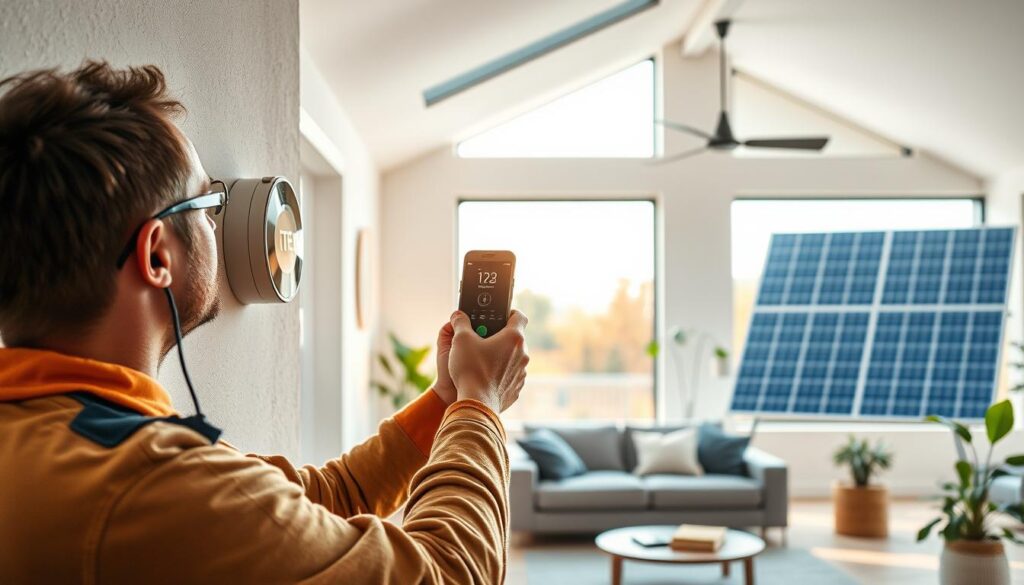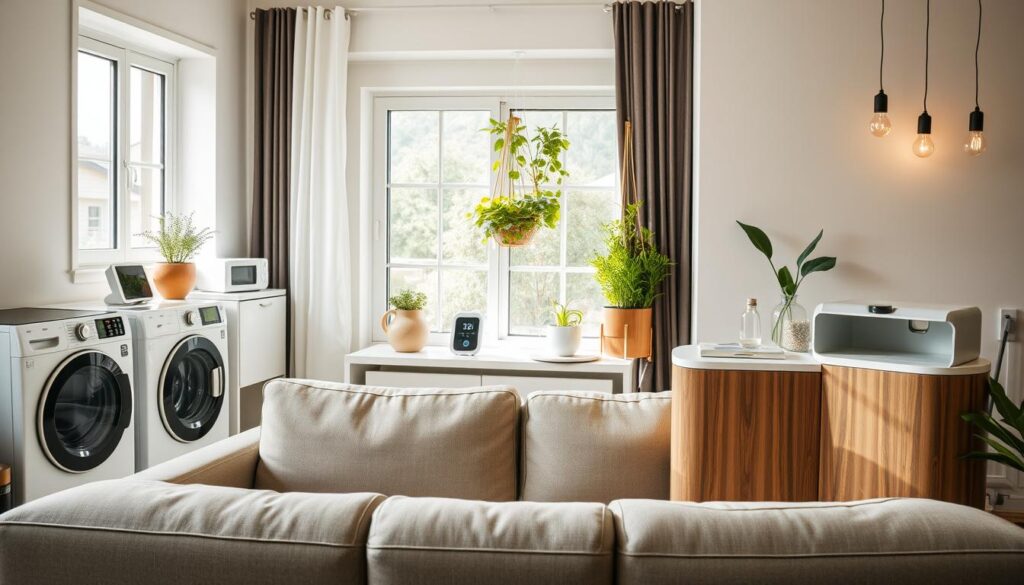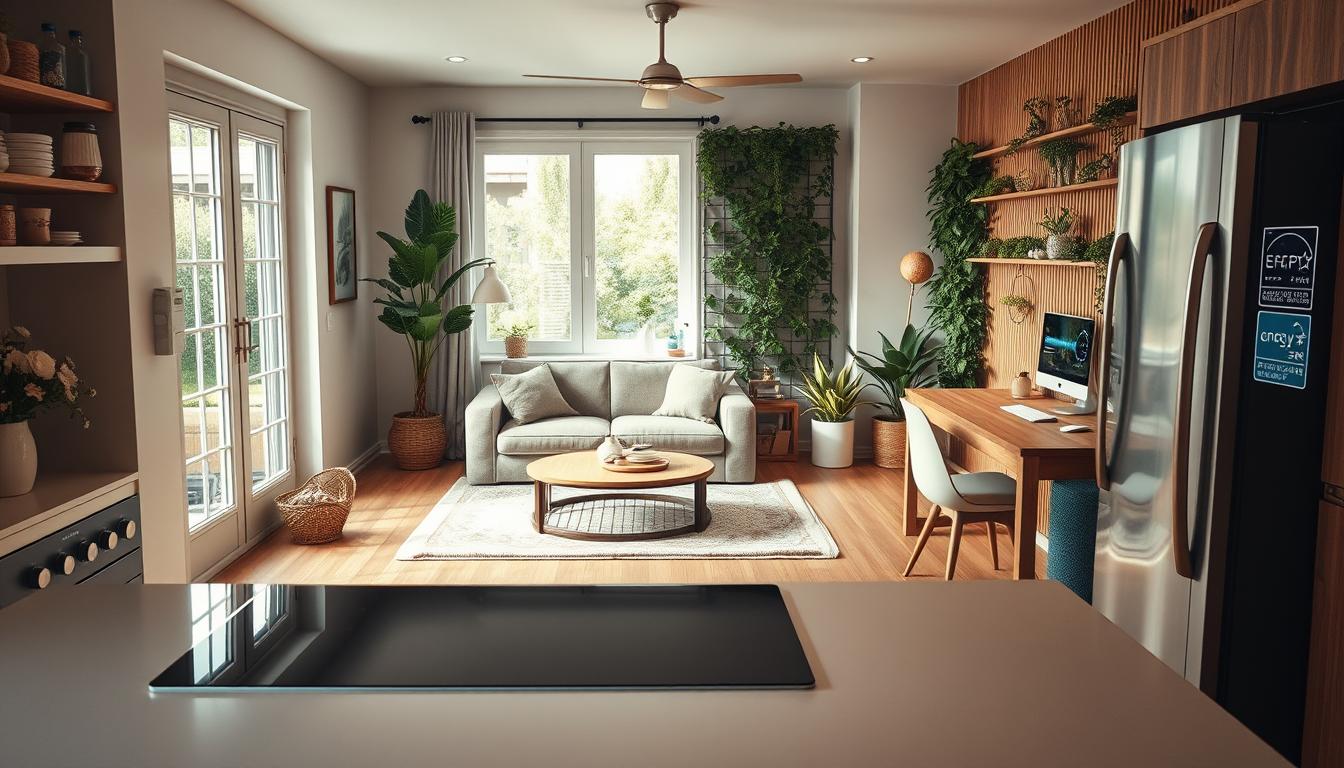Creating a green home doesn’t require a complete renovation. Modern eco-friendly gadgets for home offer simple, effective ways to reduce energy use and lower your carbon footprint. From smart thermostats to solar-powered devices, these innovations blend sustainability with everyday convenience.
Today’s market offers a wide range of eco-friendly gadgets for home that prioritize efficiency without sacrificing performance. By integrating these tools, homeowners can enjoy cost savings while contributing to global environmental goals. This guide explores how small tech upgrades can lead to big impacts on both your household and the planet.
Key Takeaways
- Eco-friendly gadgets for home help cut energy costs and emissions.
- Smart devices like thermostats and LED lights improve sustainability.
- Modern tech integrates easily into existing home setups.
- Adopting these gadgets supports both personal savings and environmental health.
- Small changes with eco-friendly gadgets for home lead to significant long-term benefits.
Introduction to Green Living and Sustainability
Green living means making choices that protect the planet without sacrificing comfort. Sustainable home gadgets are tools that make this lifestyle achievable. They help families cut waste, save energy, and support a healthier planet.
Why Eco-friendliness Matters
Adopting eco-friendly habits today shapes a better future. Here’s why it matters:
- Cuts greenhouse gas emissions linked to climate change.
- Encourages responsible use of Earth’s resources.
- Protects wildlife and natural habitats.
The Benefits of a Sustainable Home
Switching to sustainable home gadgets offers rewards for both people and the planet. Benefits include:
- Lower energy bills with smart thermostats and LED lighting.
- Better indoor air quality from air-purifying devices.
- Reduced water use with low-flow fixtures and smart sprinklers.
Understanding Energy Efficiency in Home Technologies
Choosing the right green home gadgets starts with knowing how much energy your current devices use. Tracking usage helps cut costs and reduce environmental impact. Begin by reviewing appliance labels or using smart meters to measure power draw. Simple steps like swapping old bulbs for LEDs or upgrading to Wi-Fi enabled thermostats can slash energy waste without sacrificing comfort.
Assessing Energy Consumption
Start with free tools like the U.S. Department of Energy’s online calculators to estimate savings. A quick audit highlights high-drain appliances. For example, replacing a 20-year-old fridge with an Energy Star-certified model can save $300 yearly. Use these tips:
- Monitor real-time data with smart plugs
- Optimize HVAC settings via smartphone apps
- Track seasonal usage patterns
Energy Star Ratings and What They Mean
“Energy Star certified products use 10-30% less energy than standard models.” – EPA.gov
Look for the blue Energy Star label when buying green home gadgets. This certification ensures devices meet strict efficiency standards set by the U.S. Environmental Protection Agency. Refrigerators, washers, and light fixtures with this rating often come with rebates or tax incentives. Compare models using the EnergyGuide label to see yearly cost differences between options.
Eco-friendly gadgets for home: A Comprehensive Guide
Choosing the right smart eco-friendly devices starts with understanding their role in daily life. These gadgets combine technology and sustainability to reduce environmental impact while enhancing comfort. Let’s explore top picks and how they fit into any home.
- Philips Hue Smart Bulbs: Adjustable LED lights that cut energy use by up to 80%.
- Nest Learning Thermostat: Learns routines to slash heating/cooling waste by 10-12% annually.
- EcoFlow Delta Power Station: Solar-compatible battery for off-grid energy storage, saving 30% on utility bills.
- LG ThinQ Washer/Dryer: Uses AI to optimize water and energy for laundry cycles.
| Product | Key Feature | Energy Saved | Price Range |
|---|---|---|---|
| Philips Hue | Dimmable & Wi-Fi control | 80% energy reduction | $50-$200 |
| Nest Thermostat | Machine learning automation | 10-12% annual savings | $150-$250 |
| EcoFlow Delta | Portable solar storage | 30% utility cost reduction | $800-$1,200 |
“Smart eco-friendly devices aren’t just tech—they’re a commitment to cleaner living without sacrificing convenience.”
When selecting smart eco-friendly devices, look for Energy Star ratings and compatibility with existing home systems. Check reviews and warranties to ensure longevity. Start small—like replacing old bulbs with Philips Hue—and scale up as needed. Every choice adds up to a greener home.
Sustainable Home Gadgets: Installation & Integration
Installing energy-efficient home tech doesn’t require a full home renovation. Start small and build your system gradually. Begin by mapping your home’s energy use patterns to decide where to place devices first. Most smart thermostats and sensors work best when installed in central locations, like hallways or open spaces.

“Proper placement can boost efficiency by up to 20%,” says the U.S. Department of Energy. Smart placement ensures devices communicate effectively, reducing wasted energy.
Simple Integration Tips
- Use Wi-Fi extenders in large homes to ensure all devices stay connected.
- Pair LED lighting with motion sensors to automate energy use.
- Upgrade wiring if older systems block smart gadget performance.
Optimizing Device Placement
Place solar panels where sunlight hits longest—south-facing roofs are ideal. Smart plugs and power strips belong near high-use appliances like refrigerators. For energy-efficient home tech systems, group devices on the same network to avoid signal interference.
Apps like Nest or Philips Hue simplify setup with guided placement advice. Check manuals for brand-specific spacing requirements. Integrating gadgets properly turns any home into a smarter, greener space—no engineering degree needed.
Smart Eco-friendly Devices: Features and Benefits
Modern environmentally friendly home products now come packed with smart features that simplify sustainable living. These devices use technology to save energy while blending seamlessly into daily routines.
| Feature | Benefit |
|---|---|
| Wi-Fi Connectivity | Remote control via apps |
| Sensor Automation | Adjusts settings to reduce energy use |
| Real-Time Data | Tracks and optimizes consumption |
Connectivity and Automation
Devices like the Nest Learning Thermostat and Philips Hue Smart Lighting learn user habits. They adjust heating, cooling, and lighting automatically. Integration with systems like Ecobee or Samsung SmartThings creates a network of devices that work together to cut waste.
Cost Savings and Performance
- Energy bills drop by 10-30% through automated efficiency
- Long-term savings offset initial costs (e.g., solar-powered devices)
- Improved performance means devices last longer, reducing e-waste
Smart features like motion-activated sensors in Belkin WeMo plugs save electricity by powering off unused devices. Over time, these upgrades pay for themselves while cutting carbon footprints.
Environmentally Friendly Home Products for Every Room
Transform your living space with eco-conscious home appliances that merge style and sustainability. From lighting to decor, every choice can contribute to a greener home. Start in the living room where innovation meets comfort.
Living Room Innovations

- Philips Hue LED Bulbs: Dimmable and long-lasting, reducing energy use by up to 80% compared to traditional options.
- Nest Thermostat: Learns your habits to cut heating/cooling waste while maintaining comfort.
- IKEA KUNGSBACKA Shelving Units: Made from reclaimed wood, blending storage with eco-friendly materials.
These products prove eco-conscious home appliances enhance design. Philips lighting adds warmth without excess energy. Nest devices simplify efficiency, while IKEA furniture turns recycled materials into modern accents. Pair these with solar-powered Bluetooth speakers or organic cotton throw blankets for a complete look.
Every detail counts. Swap traditional decor with items like bamboo flooring or biodegradable rugs. Brands like Ecovative offer mushroom-based cushions that decompose safely. Even small changes, like energy-saving streaming devices, add up to a greener lifestyle.
Green Home Innovations: Trends and Future Perspectives
Tomorrow’s sustainable living gadgets promise smarter, cleaner homes. Innovations like solar-powered window films and AI-driven energy monitors are already hitting markets. Companies like Tesla and Philips are leading the charge with products that blend tech and ecology seamlessly.
- Solar-integrated materials: Windows that generate energy while blocking heat.
- Biodegradable devices: Electronics designed for easy recycling or composting.
- AI optimization: Systems learning household habits to reduce waste automatically.
“The next decade will see sustainable living gadgets becoming as common as smartphones,” says Dr. Lena Torres, a clean tech researcher. “Innovation isn’t just about gadgets—it’s about rethinking how homes interact with the planet.”
Emerging trends also focus on modular designs. Imagine lighting systems that adapt to natural light levels or insulation that adjusts based on weather forecasts. Brands like Ecobee and LG are testing prototypes that merge these concepts into everyday appliances.
Adopting these innovations starts small. Start with:
- Upgrading to Wi-Fi enabled thermostats that learn energy use patterns. 2.Learning about government rebates for eco-tech installations. 3. Exploring community solar programs.
From smart sensors that track water usage to 3D-printed furniture made from recycled plastics, the future is here. As tech evolves, so do opportunities to make sustainability effortless. The key? Staying curious about what’s next—and how it can transform daily life.
Overcoming Challenges in Sustainable Living with Home Tech
Transitioning to a sustainable lifestyle with green home innovations can sometimes feel tricky. Technical hiccups or maintenance confusion may arise, but most issues have easy fixes. Let’s explore practical solutions to keep your eco-friendly gadgets running smoothly.
Troubleshooting Common Issues
- Connectivity problems: Reset devices or check Wi-Fi signals. For instance, a Nest thermostat not syncing? Unplug it for 5 minutes to reboot.
- Sensor malfunctions: Clean sensors on motion-activated lights (like Philips Hue) or smart sprinklers to restore accuracy.
- Incompatibility: Use certified accessories with systems like Samsung SmartThings to ensure seamless integration.
Maintenance Best Practices
Regular upkeep keeps green home innovations efficient:
- Conduct monthly inspections of solar panels or smart HVAC systems for wear and tear.
- Wipe dust from vents and sensors to maintain performance.
- Update device software regularly via manufacturer apps (e.g., LG ThinQ) for optimal energy use.
- Schedule annual professional servicing for complex systems like geothermal heat pumps.
Small steps like these turn challenges into opportunities to refine your eco-friendly setup. With proactive care, your investments in green home innovations will keep delivering long-term benefits.
Conclusion
Adopting eco-friendly gadgets and sustainable practices transforms everyday life into an act of environmental stewardship. From energy-efficient appliances to smart home systems, these tools make reducing waste and lowering carbon footprints achievable. Every choice—from LED bulbs to solar panels—adds up to meaningful change.
Begin with small steps like replacing old devices with Energy Star-certified models or installing a Nest thermostat. Brands like Philips Hue offer smart lighting that saves energy, while companies like LG provide solar solutions to power homes. These innovations blend convenience with sustainability, proving eco-conscious living doesn’t mean sacrificing comfort.
A sustainable home isn’t just a trend; it’s a commitment to cleaner air, lower bills, and a healthier planet. Explore options like smart water sensors or composting systems to deepen your impact. By integrating these technologies, you join a global shift toward greener living. Your home can be both a haven and a force for positive change. Start today—your choices today shape tomorrow’s world.
FAQ
What are eco-friendly gadgets for home?
Eco-friendly gadgets for home are devices specifically designed to reduce energy consumption and minimize environmental impact. They often feature energy-efficient technology, sustainable materials, and smart functionalities that help promote a greener lifestyle.
How can I integrate sustainable home gadgets into my existing setup?
Integrating sustainable home gadgets can be straightforward! Start by assessing your current devices, then select eco-friendly alternatives that match your lifestyle. Additionally, ensure proper placement and connection of smart devices for optimal performance.
What are some examples of energy-efficient home tech?
Some popular examples of energy-efficient home tech include smart thermostats like the Nest Learning Thermostat, energy-saving LED bulbs, smart power strips, and eco-friendly appliances like Energy Star-rated washers and dryers.
How can smart eco-friendly devices help save on utility bills?
Smart eco-friendly devices can significantly reduce utility bills by optimizing energy usage. For instance, smart thermostats adjust heating and cooling based on your habits, while energy monitoring plugs can track and mitigate power usage, leading to substantial savings over time.
Are there environmentally friendly home products available for all rooms?
Yes! There are eco-friendly solutions for every room, including energy-efficient appliances for kitchens, low-flow showers for bathrooms, and sustainable furniture for living areas. Brands like Philips and EcoSmart offer a wide range of options to choose from.
What trends are shaping the future of green home innovations?
Current trends in green home innovations include advancements in solar energy tech, smart home automation, and improved energy storage solutions. These innovations not only enhance sustainability but also improve convenience and efficiency in daily living.
How can I troubleshoot common issues with eco-friendly gadgets?
Troubleshooting eco-friendly gadgets generally involves checking power connections, ensuring they are updated with the latest software, and consulting user manuals. Many manufacturers also provide customer support for additional assistance.
What maintenance practices should I follow for smart eco-friendly devices?
Regularly cleaning devices, checking for software updates, and ensuring proper placement for optimal efficiency are essential maintenance practices. This will help keep your gadgets running smoothly and prolong their lifespan, making sure they contribute effectively to your sustainable living goals.
